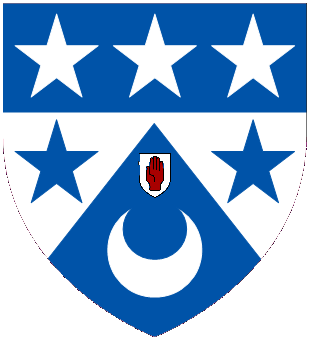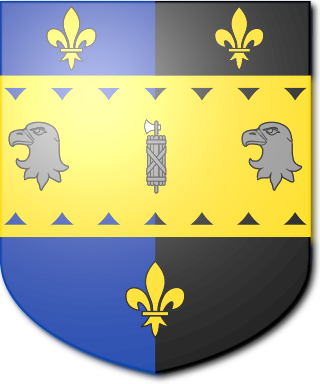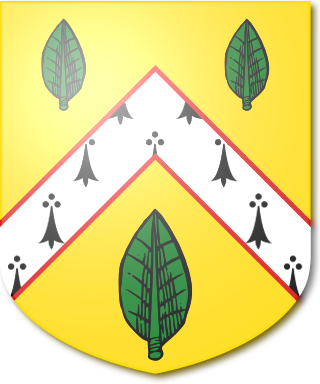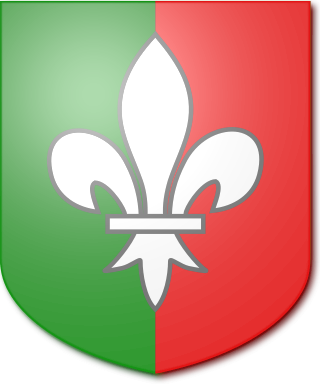
The Ramsay baronetcy, of Bamff in the County of Perth, was created in the Baronetage of Nova Scotia on 3 December 1666 for Gilbert Ramsay. [1] The title became extinct on the death of the twelfth Baronet in 1986. [2]

The Ramsay baronetcy, of Bamff in the County of Perth, was created in the Baronetage of Nova Scotia on 3 December 1666 for Gilbert Ramsay. [1] The title became extinct on the death of the twelfth Baronet in 1986. [2]

Viscount Hardinge, of Lahore and of Kings Newton in the County of Derby, is a title in the Peerage of the United Kingdom. It was created in 1846 for the soldier and Tory politician Sir Henry Hardinge. His son, the second Viscount, represented Downpatrick in Parliament. His great-great-grandson, the sixth Viscount, succeeded a distant relative as eighth Baronet, of Belle Isle in the County of Fermanagh, in 1986. This title had been created in the Baronetage of the United Kingdom 1801 for Richard Hardinge. He was the third son of Nicolas Hardinge, younger brother of Reverend Henry Hardinge and uncle of the latter's third son Henry Hardinge, 1st Viscount Hardinge. The baronetcy was created with special remainder to the heirs male of Richard Hardinge's father.

The Eliott Baronetcy, of Stobs in the County of Roxburgh, is a title in the Baronetage of Nova Scotia. It was created on 3 December 1666 for Gilbert Eliott. The second baronet was a member of the pre-union Parliament of Scotland. The third Baronet sat as Member of Parliament for Roxburghshire. The Eliott Baronets share a common early Elliot ancestry with the nearby Earls of Minto (Elliot). It is thought that the surname spelling differences were contrived to differentiate the branches.

The Arnott Baronetcy, of Woodlands in the Parish of St Anne, Shandon in the County of Cork, is a title in the Baronetage of the United Kingdom. It was created on 12 February 1896 for the Irish entrepreneur and philanthropist John Arnott.

The Bunbury Baronetcy, of Bunbury, Oxon and Stanney Hall in the County of Chester, is a title in the Baronetage of England. It was created on 29 June 1681 for Thomas Bunbury, Sheriff of Cheshire from 1673 to 1674 and the member of an ancient Cheshire family. His grandson, Henry, the third Baronet, and great-grandson, the fourth Baronet, both sat as Members of Parliament for Chester. The latter died unmarried at an early age and was succeeded by his younger brother, the fifth Baronet. He was a clergyman. On his death in 1764 the title passed to his eldest son, the sixth Baronet. He represented Suffolk in the House of Commons for over forty years but is best remembered for his marriage to Lady Sarah Lennox. He died childless in 1821 and was succeeded by his nephew, the seventh Baronet. He was the son of Henry Bunbury, younger son of the fifth Baronet. The seventh Baronet was a distinguished soldier and politician. His eldest son, the eighth Baronet, was High Sheriff of Suffolk in 1868, and Fellow of the Royal Society. He died childless in 1886 and was succeeded by his younger brother, the ninth Baronet. He was Liberal Member of Parliament for Bury St Edmunds. He died unmarried in 1895 and was succeeded by his nephew, the tenth Baronet. He was the son of Colonel Henry William St Pierre Bunbury, third son of the seventh Baronet. He served as High Sheriff of Suffolk in 1908 and was a Deputy Lieutenant of the county. On his death in 1930 the title passed to his son, the eleventh Baronet. He was High Sheriff of Suffolk in 1936 and was a Deputy Lieutenant of the county. His son, the twelfth Baronet, was High Sheriff of Suffolk in 1972. As of 2014 the title was held by the latter's second but eldest surviving son, the thirteenth Baronet, who succeeded in 1985.

The Bagge Baronetcy, of Stradsett Hall in the County of Norfolk, is a title in the Baronetage of the United Kingdom. It was created on 13 April 1867 for William Bagge, Conservative Member of Parliament for West Norfolk. The sixth Baronet was Chairman of the West Norfolk District Council between 1976 and 1977.

The Whitehead Baronetcy, of Highfield House in Catford Bridge in the County of Kent, is a title in the Baronetage of the United Kingdom. It was created on 26 November 1889 for James Whitehead, Lord Mayor of London between 1888 and 1889 and later member of parliament for Leicester. His younger son, the third baronet, was also a Member of Parliament.

There have been two baronetcies created for the Guise family, one in the Baronetage of England and one in the Baronetage of Great Britain. The latter creation is extant as of 2014.

The Chance Baronetcy, of Grand Avenue in the parish of Hove in the County of Sussex, is a title in the Baronetage of the United Kingdom. It was created on 19 June 1900 for James Timmins Chance, a grandson of William Chance, one of the Chance brothers who started the family business in 1771. He became head of Chance Brothers and Company. He was High Sheriff of Staffordshire in 1868.

The Broadbent Baronetcy, of Longwood in the Parish of Huddersfield in the West Riding of the County of York, and of Brook Street, in the Parish of St George Hanover Square in the County of London, is a title in the Baronetage of the United Kingdom. It was created on 10 August 1893 for the noted physician William Broadbent, personal physician to Queen Victoria. The title descended from father to son until the death of his grandson, the third Baronet, in 1987. The late Baronet was succeeded by his first cousin once removed, the fourth Baronet. He was the grandson of Walter Broadbent, third son of the first Baronet.

The Couper Baronetcy is a title in the Baronetage of the United Kingdom. It was created on 23 June 1841 for George Couper. He was a colonel in the Army and fought in the Peninsular War, served as Military Secretary to the Governors General of Canada, Sir James Kempt and Lord Durham, and was Comptroller of the Household and Equerry to Her Royal Highness the Duchess of Kent. The second Baronet was an administrator in India and served as Governor of the North-West Provinces between 1877 and 1882. Another member of the family to gain distinction was James Kempt Couper, second son of the first Baronet. He was a general in the Army.

The Fletcher, later Boughey Baronetcy, of Newcastle-under-Lyme and of Betley both in the County of Stafford, is a title in the Baronetage of Great Britain. It was created on 24 August 1798 for Thomas Fletcher, of Betley Court, Staffordshire, High Sheriff of Staffordshire in 1783 and 1789 and Deputy Lieutenant of the county. He was the husband of Elizabeth Fenton, granddaughter of George Boughey, of Audley, Staffordshire whose will provided for his great-grandson to inherit the Audley estate.

The ffolkes Baronetcy, of Hillington in the County of Norfolk, is a title in the Baronetage of Great Britain. It was created on 26 May 1774 for Martin ffolkes, FRS later High Sheriff of Norfolk and Member of Parliament for King's Lynn. The second Baronet represented Norfolk and Norfolk West in the House of Commons while the third Baronet represented King's Lynn. The fifth Baronet was Honorary Chaplain to Queen Victoria, Chaplain-in-Ordinary to Edward VII and George V and Chaplain to Edward VIII and George VI.

The Milman Baronetcy, of Levaton-in-Woodland in the County of Devon, is a title in the Baronetage of Great Britain. It was created on 28 November 1800 for Francis Milman, Physician-in-Ordinary to King George III and President of the Royal College of Physicians. The seventh Baronet was a brigadier-general in the British Army.

The Smith, later Smith-Marriott Baronetcy, of Sydling St Nicholas in the County of Dorset, is a title in the Baronetage of Great Britain. It was created on 1 June 1774 for John Smith, High Sheriff of Dorset in 1772. The second Baronet married Elizabeth Anne, daughter of Reverend James Marriott. The fourth Baronet assumed by Royal sign-manual the additional surname of Marriott. The fifth Baronet was High Sheriff of Dorset in 1873.

The Hoghton or Houghton, later Bold-Hoghton, later de Hoghton Baronetcy, of Hoghton Tower in the County of Lancashire, is a title in the Baronetage of England. It was created on 22 May 1611 for Richard Hoghton, Member of Parliament for Lancashire. The Hoghton family had been landowners in Lancashire since the reign of King Stephen and had been Knights of the Shire for Lancashire since the 14th century. The second Baronet represented Clitheroe and Lancashire in the House of Commons and was a Royalist leader during the Civil War. The third and fourth Baronets both sat as Members of Parliament for Lancashire. The fifth Baronet was Member of Parliament for Preston and East Looe while the sixth and seventh Baronets represented Preston. The eighth Baronet assumed the additional surname of Bold. In 1892 the ninth Baronet resumed, by Royal licence, the ancient family surname of de Hoghton.

The Palmer Baronetcy, of Carlton in the County of Northampton, was created in the Baronetage of England on 7 June 1660 for the lawyer and politician Geoffrey Palmer. The second Baronet was Member of Parliament for Higham Ferrers. The third, fourth and fifth Baronets all represented Leicestershire in the House of Commons. The fifth Baronet served as High Sheriff of Leicestershire in 1782 and the eighth Baronet as High Sheriff of Northamptonshire in 1871.

The Mackenzie baronetcy, of Coul (Coull) in the County of Ross, was created in the Baronetage of Nova Scotia on 16 October 1673 for Kenneth Mackenzie. His father Alexander Mackenzie of Coul was the illegitimate son of Colin Cam Mackenzie, 11th of Kintail, and half-brother of Kenneth Mackenzie, 1st Lord Mackenzie of Kintail, ancestor of the Earls of Seaforth, and of Sir Roderick Mackenzie, ancestor of the Earls of Cromarty. The 3rd Baronet was involved in the Jacobite rising of 1715. He was attainted with the baronetcy forfeited.
The Mackenzie baronetcy, of Scatwell in the County of Ross, was created in the Baronetage of Nova Scotia on 22 February 1703 for Kenneth Mackenzie, who represented Ross-shire in the Scottish Parliament. He was a descendant of Kenneth Mackenzie, brother of the 1st Baronet of the 1628 creation. The 5th Baronet represented Ross-shire in the British Parliament and was Lord Lieutenant of Ross-shire.

The Macdonald baronetcy, later Bosville Macdonald Baronetcy, of Sleat in the Isle of Skye, County of Inverness, was created in the Baronetage of Nova Scotia on 14 July 1625 for Donald Macdonald. The 9th baronet was created Baron Macdonald in 1776.

The Forbes baronetcy, of Craigievar in the County of Aberdeen, was created in the Baronetage of Nova Scotia on 20 April 1630 for William Forbes, son of the merchant William Forbes who built Craigievar Castle. He was also a descendant of Hon. Patrick Forbes, third son of the 2nd Lord Forbes, and the nephew of the 1st Baronet of the 1628 creation.